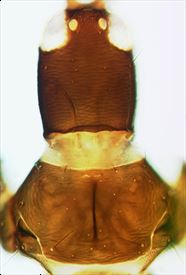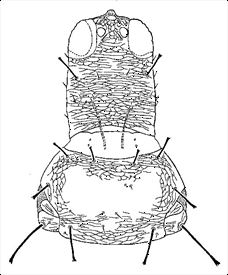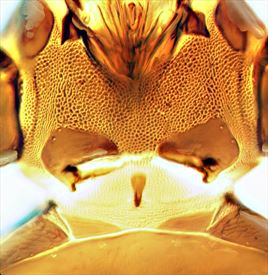Distinguishing features
Both sexes fully winged. Female dark brown to black; tarsi, apices of middle and hind tibiae, and distal two-thirds of fore tibiae paler; antennal segments I, VII, and VIII brown, apex of II and basal half of III–VI pale; major setae pale brown; fore wing frequently shaded medially and at base. Head longer than wide, strongly sculptured; ocelli well developed; compound eyes smaller ventrally than dorsally; postocular setae expanded at apex, arising laterally; postocellar setae fine; maxillary stylets retracted about halfway to postocular setae, one third of head width apart. Antennae 8-segmented; segments VII and VIII separate but broadly joined; segment III with 1 long sense cone, IV with 3 long sense cones. Pronotum sculptured near margins; major setae with capitate apices, epimerals longest; epimeral sutures complete; basantra absent. Mesopresternum comprising 2 lateral triangles. Metanotum reticulate; metathoracic sternopleural sutures present. Fore tarsal tooth present. Fore wing parallel sided, with 2–9 duplicated cilia and with 3 major subequal, capitate sub-basal setae. Pelta irregularly triangular; tergites II–VII each with 2 pairs of sigmoid wing-retaining setae; tergite IX posteromarginal setae with capitate apices, S1 shorter than S2, S3 longer, finely acute; tube slightly constricted in proximal third and at apex; anal setae long.
Male similar to female; large males with femora swollen, fore tarsal tooth large; sternite VIII with a large, transverse pore plate; tergite IX setae S2 shorter than S1, with apices expanded, S3 long, finely acute.
Related species
A total of 23 species are listed in the genus Teuchothrips, of which 16 are Australian endemics (Mound, 2008). One of these, T. disjunctus, has been introduced to New Zealand on its commonly cultivated bottle brush host plant. The genus is essentially similar to Liothrips, but the species have antennal segment VIII shorter, and the pronotal major setae less elongate. In contrast to the related genus Klambothrips, the head does not have any stout cheek setae.
Biological data
This species is most commonly found inducing leaf-roll galls on young leaves of the commonly cultivated bottlebrush, Callistemon citrinum.
Distribution data
Described originally from northern Australia, this species is widespread in eastern Australia, and occurs widely on its cultivated host plant in New Zealand (ND, AK, WO, BP, TO, WI / NN, MC).
Family name
PHLAEOTHRIPIDAE, PHLAEOTHRIPINAE
Species name
Teuchothrips disjunctus (Hood)
Original name and synonyms
Liothrips disjunctus Hood, 1918: 654
References
Mound LA (2008) Identification and host associations of some Thysanoptera Phlaeothripinae described from Australia pre-1930. Zootaxa 1714: 41–60.
Mound LA & Walker AK (1986) Tubulifera (Insecta: Thysanoptera). Fauna of New Zealand 10: 1–140.




